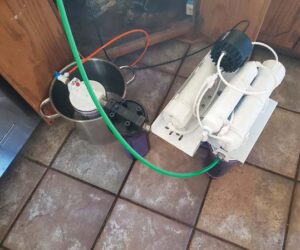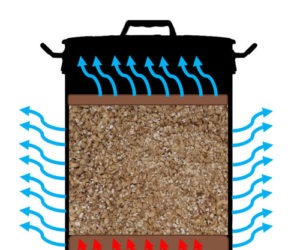Water Control System: Making the most of a float switch

One of the things that I enjoy about homebrewing is customizing my brewing system. I have built several contraptions to help improve the quality of my beer, make brew day go more smoothly, and reduce the risk of the mishaps that can add unneeded frustration. One of the things I built with those goals in mind is my water control system.
The water control system helps with three aspects of the brewing process: Filtration, hot liquor tank (HLT) fill, and sparging. First, the system filters the chlorination from the tap water. Second, it controls the water level when the HLT is being filled, automatically shutting off the water flow when the set point is reached. (Ever had a time when you got distracted and overfilled the hot liquor tank?) Third, during sparging, the system maintains a constant level of water in my mash/lauter tun (MLT), preventing the grain bed from inadvertently running dry.
The water level control assembly consists of several parts. There is a T-shaped frame of PVC pipe that sits on top of the HLT or MLT. Through a hole drilled in the T-frame, a piece of CPVC pipe is friction fit perpendicular to the T-frame. The CPVC pipe serves as the water level adjustment rod. At the bottom of the adjustment rod is a float switch. Slide the rod down through the cutout in the T-frame until the float switch is at the desired water level. Because the adjustment rod is tightly held in the T-frame, the float switch stays at the water level set point.
When the HLT is being filled, the float switch control sends a signal to a relay to open a solenoid valve, then closing when the float switch is triggered by the water. The solenoid valve that I used is from a dishwasher, but a dishwasher solenoid needs to be properly enclosed. Other kinds of valves, such as the 12V stainless steel solenoid valve listed below, would also work. When it is time to sparge, the water level control assembly is moved to the MLT, and the float switch now controls power to an electrical outlet into which my brew pump is plugged.
The control box is where the connections are made amongst the main electrical components. I used switches to turn the solenoid valve on to start the HLT fill and to turn the pump on and off for sparging. The control box includes an electrical outlet into which the pump is plugged for use during sparging. It also includes a connection from the float switch on the water level control assembly. I also used a 12V power supply because of the risk of running 120VAC current into the tank, and because most float switches are only rated for less than 50 volts. Be sure to cover any exposed 120VAC conductors inside the electrical enclosure.
Tools and Materials
- 1⁄2-in. NPT stainless solenoid valve (U.S. Solid USS2-00069)
- Float switch
- Relay
- 15 amp marine inlet
- Electrical enclosure box
- Control switches
- AC to DC power supply 12V 5A 60W
- 15 amp electrical outlet
- Water filter
- Length of PVC and CPVC pipe
- (1) PVC T-fitting
- (2) CPVC endcaps
- Silicone sealant
- Wood and screws for building the mounting board
- Miscellaneous wire, terminals, fuses, and electrical components
- Conduit and connector
- Saws for PVC pipe and wood
- Drill or drill press, drill bits
- Wire cutters
*Brewing with electricity can be hazardous. There is a risk of electrical shock or death. If you decide to build this system, your design and finished project should be reviewed by a licensed electrician. Any 120VAC power used in brewing operations should be protected by a Ground Fault Circuit Interrupter (GFCI).


